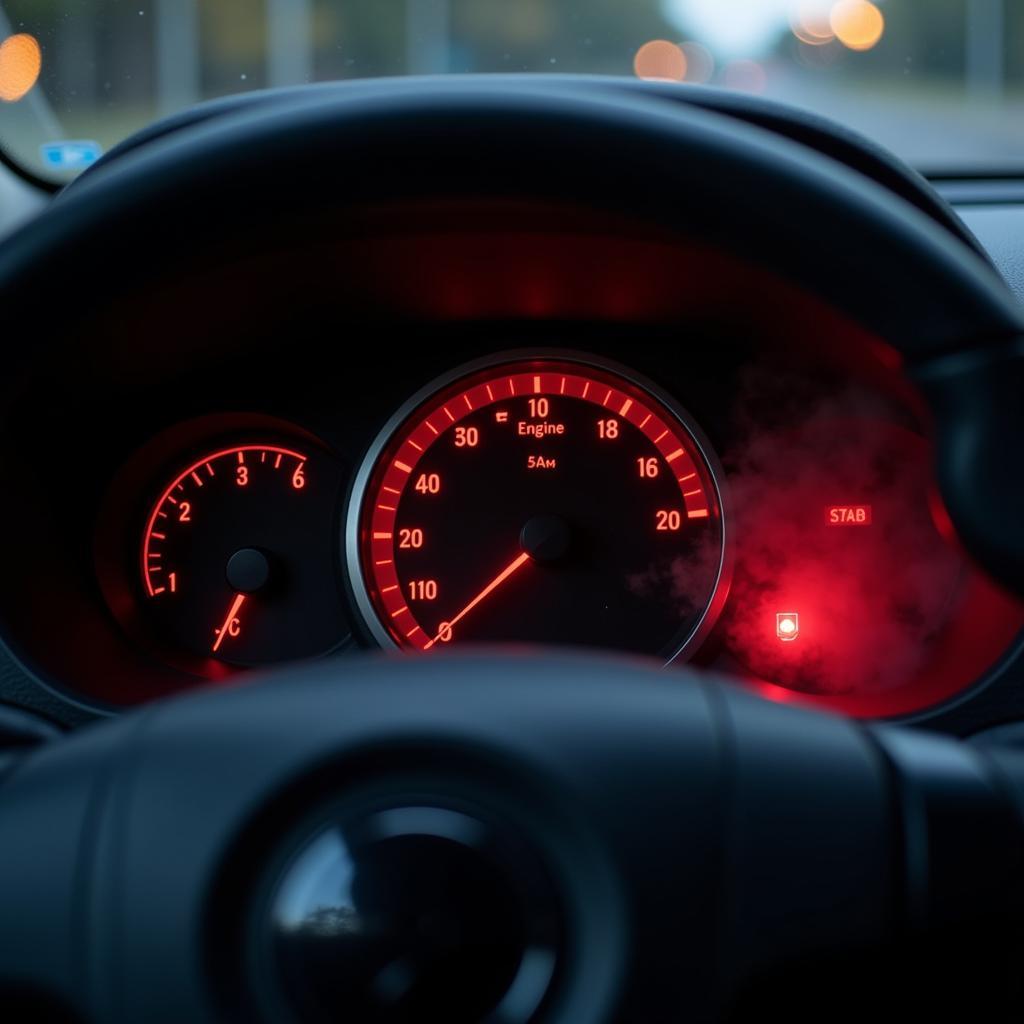Overheating is a common car problem that can lead to serious engine damage if not addressed promptly. Fixing Car Overheating Problems involves understanding the various causes and implementing the correct solutions. This guide will help car owners, mechanics, and technicians diagnose and fix overheating issues effectively.
 Car engine overheating dashboard warning light
Car engine overheating dashboard warning light
Understanding the Cooling System
Your car’s cooling system is designed to regulate the engine temperature and prevent overheating. Key components include the radiator, water pump, thermostat, hoses, and coolant. A malfunction in any of these components can cause fixing car overheating problems to become a necessity. For example, a failing thermostat can prevent coolant from circulating properly, leading to a rapid increase in engine temperature. car thermostat problem symptoms can help you identify this specific issue.
Common Causes of Overheating
Several factors can contribute to car overheating. Low coolant levels, a faulty thermostat, a leaking radiator, a malfunctioning water pump, and a clogged radiator are among the most common culprits. External factors like extreme weather conditions can also exacerbate overheating problems.
Diagnosing the Problem
Fixing car overheating problems starts with accurate diagnosis. Begin by checking the coolant level. If it’s low, top it off and monitor the situation. Inspect the radiator and hoses for leaks. A leaking radiator will require repair or replacement. A malfunctioning water pump will prevent coolant circulation and needs to be replaced. If you suspect a thermostat issue, check for car thermostat problem symptoms.
Why is my car overheating?
Overheating occurs when the cooling system can’t effectively dissipate the heat generated by the engine. This can be due to various reasons, from low coolant levels to a faulty water pump.
Fixing Car Overheating Problems: Step-by-Step Guide
- Check the coolant level: Ensure the engine is cool before opening the radiator cap. Top off the coolant if necessary.
- Inspect the radiator and hoses: Look for leaks or cracks. Replace any damaged components.
- Test the thermostat: A faulty thermostat can prevent coolant from circulating properly.
- Check the water pump: A malfunctioning water pump won’t circulate coolant effectively.
- Inspect the radiator fan: The fan helps cool the radiator. Make sure it’s working correctly.
- Check for blockages: A clogged radiator can restrict coolant flow.
Expert Insight: “Regular maintenance is crucial for preventing overheating. Ensure your coolant is flushed and replaced according to the manufacturer’s recommendations,” says John Miller, Automotive Engineer at Miller Automotive Solutions.
Preventing Overheating
Regular maintenance is key to preventing fixing car overheating problems. Ensure your coolant is flushed and replaced according to the manufacturer’s recommendations. Regular inspections of the cooling system components can help identify potential problems early on. If you notice any unusual noises or temperature fluctuations, address them promptly. Understanding [what is transmission problem in car](https://autotippro.com/what is-transmission-problem-in-car/) can also help you differentiate between transmission and overheating issues. Certain transmission problems can manifest as overheating symptoms. Similarly, catalytic converter in cars problems can sometimes contribute to overall engine heat, indirectly affecting the cooling system.
Expert Insight: “Don’t ignore warning signs like the temperature gauge rising or steam coming from under the hood. Addressing these issues early can prevent costly repairs,” advises Sarah Johnson, Lead Mechanic at Johnson Auto Repair.
Sometimes, car problems can be humorous, especially when looking back. Check out some relatable scenarios at car problems funny picture. For owners of specific car brands, understanding common issues can be helpful. For example, problems in hyundai car and solutions provides valuable information for Hyundai owners.
Conclusion
Fixing car overheating problems requires a systematic approach. By understanding the cooling system, diagnosing the problem accurately, and following the step-by-step guide, you can effectively address overheating issues. Regular maintenance and prompt attention to warning signs are crucial for preventing overheating and ensuring the longevity of your engine. For further assistance and expert advice, contact AutoTipPro at +1 (641) 206-8880 or visit our office at 500 N St Mary’s St, San Antonio, TX 78205, United States.
Expert Insight: “Remember, prevention is always better than cure. Regular checks and timely maintenance can save you from the hassle and expense of fixing car overheating problems,” concludes David Lee, Senior Automotive Technician at Lee Auto Services.







Leave a Reply